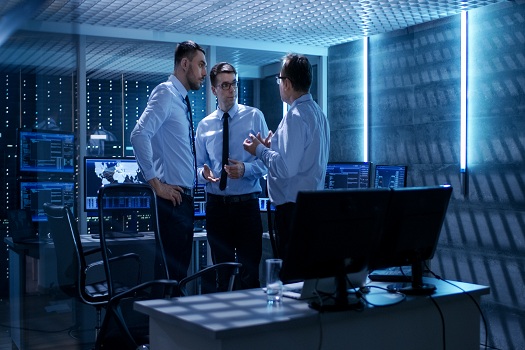From Cybersecurity to Physical Measures: Reinforcing Business Safety And Security in a Transforming World
By incorporating the toughness of both cybersecurity and physical protection, firms can create a thorough defense technique that addresses the varied array of dangers they deal with. In this discussion, we will discover the transforming risk landscape, the requirement to integrate cybersecurity and physical safety and security, the implementation of multi-factor authentication actions, the relevance of worker recognition and training, and the adaptation of security measures for remote labor forces. By examining these essential locations, we will certainly acquire valuable insights into how companies can reinforce their company safety in an ever-changing world.
Understanding the Transforming Hazard Landscape
The progressing nature of the contemporary globe necessitates an extensive understanding of the changing danger landscape for effective company protection. In today's interconnected and electronic age, dangers to business safety have ended up being more complicated and advanced. As technology breakthroughs and companies come to be progressively reliant on digital framework, the potential for cyberattacks, information breaches, and various other security breaches has actually considerably boosted. It is essential for organizations to remain educated and adapt their safety and security measures to deal with these advancing risks.
One trick facet of understanding the changing risk landscape is acknowledging the various sorts of dangers that companies encounter. Cybercriminals are continuously establishing brand-new methods to manipulate vulnerabilities in computer systems and networks. These risks can range from malware and ransomware attacks to phishing frauds and social engineering techniques. In addition, physical dangers such as burglary, vandalism, and corporate espionage continue to be widespread concerns for businesses.
Surveillance and examining the threat landscape is important in order to identify possible dangers and vulnerabilities. This includes staying upgraded on the most recent cybersecurity patterns, analyzing danger knowledge reports, and carrying out regular threat evaluations. By comprehending the changing hazard landscape, organizations can proactively apply ideal protection steps to mitigate dangers and shield their possessions, reputation, and stakeholders.
Integrating Cybersecurity and Physical Protection
Integrating cybersecurity and physical safety and security is important for comprehensive company security in today's electronic and interconnected landscape. As companies progressively rely on technology and interconnected systems, the borders between physical and cyber hazards are ending up being obscured. To properly protect versus these threats, an alternative method that incorporates both cybersecurity and physical safety and security actions is important.
Cybersecurity focuses on protecting digital properties, such as systems, networks, and information, from unauthorized gain access to, disturbance, and theft. Physical safety, on the various other hand, includes actions to secure physical assets, people, and centers from threats and vulnerabilities. By integrating these 2 domain names, companies can attend to susceptabilities and threats from both digital and physical angles, thus enhancing their overall protection stance.
The integration of these 2 disciplines enables for an extra extensive understanding of safety and security dangers and enables a unified reaction to occurrences. For instance, physical access controls can be boosted by incorporating them with cybersecurity methods, such as two-factor verification or biometric identification. Cybersecurity measures can be enhanced by physical safety procedures, such as monitoring cams, alarms, and safe access factors.

Applying Multi-Factor Verification Actions
As organizations increasingly focus on comprehensive safety and security measures, one effective strategy is the application of multi-factor verification measures. Multi-factor authentication (MFA) is a safety approach that requires individuals to offer numerous types of recognition to access a system or application. This method includes an additional layer of protection by combining something the customer understands, such as a password, with something they have, like a finger print or a protection token.
By implementing MFA, organizations can significantly improve their protection position - corporate security. Traditional password-based authentication has its restrictions, as passwords can be conveniently endangered or forgotten. MFA minimizes these threats by about his including an added authentication aspect, making it extra hard for unapproved people to acquire accessibility to delicate details
There are several sorts of multi-factor verification methods offered, including biometric authentication, SMS-based Get the facts confirmation codes, and equipment symbols. Organizations require to analyze their certain demands and choose the most proper MFA solution for their requirements.
Nonetheless, the application of MFA ought to be meticulously prepared and performed. It is important to strike a balance between protection and functionality to stop customer stress and resistance. Organizations ought to likewise think about prospective compatibility concerns and offer appropriate training and assistance to ensure a smooth shift.
Enhancing Employee Awareness and Training
To strengthen corporate protection, organizations must focus on enhancing staff member understanding and training. In today's swiftly developing threat landscape, staff members play a critical duty in safeguarding a company's delicate information and possessions. Regrettably, numerous protection breaches take place because of human error or absence of recognition. Organizations require to spend in detailed training programs to inform their employees about possible threats and the best techniques for minimizing them.
Reliable worker recognition and training programs should cover a broad range of topics, consisting of information protection, phishing assaults, social design, password health, and physical safety steps. These programs must be customized to the details needs and obligations of different worker roles within the company. Routine training sessions, simulations, and workshops can aid workers create the required skills and understanding to react and identify to safety and security risks properly.
In addition, companies must motivate a society of security awareness and give ongoing updates and tips to keep staff members informed regarding the current hazards and reduction methods. This can be done via inner communication channels, such as e-newsletters, intranet websites, and email campaigns. By promoting a security-conscious labor force, companies can dramatically lower the probability of safety incidents and protect their useful properties from unapproved access or concession.

Adapting Safety Steps for Remote Labor Force
Adapting company security steps to suit a remote workforce is essential in guaranteeing the security of delicate info and possessions (corporate security). With the enhancing fad of remote job, companies must implement suitable protection steps to reduce the risks connected with this new means of working
One essential facet of adjusting protection actions for remote job is developing safe communication channels. Encrypted messaging platforms and digital exclusive networks (VPNs) can help protect sensitive information and protect against unapproved gain access to. In addition, companies need to impose the use of solid passwords and multi-factor verification to enhance the safety and security of remote gain access to.
One more important factor to consider is the execution of secure remote gain access to options. This entails supplying employees with secure accessibility to corporate resources and data via digital desktop facilities (VDI), remote desktop procedures (RDP), or cloud-based solutions. These modern technologies make sure that delicate info remains safeguarded while enabling workers to execute their duties efficiently.

Lastly, thorough safety recognition training is crucial for remote employees. Educating sessions ought to cover finest methods for securely accessing and taking care of sensitive details, identifying and reporting phishing attempts, and preserving the total cybersecurity hygiene.
Verdict
Finally, as the danger landscape proceeds to develop, it is essential for companies to strengthen their safety and security determines both in the cyber and physical domain names. Integrating cybersecurity and physical protection, carrying out multi-factor verification measures, and boosting staff member recognition and training are these details essential steps towards attaining durable business safety and security. Furthermore, adapting safety and security measures to suit remote labor forces is critical in today's transforming globe. By implementing these measures, companies can alleviate risks and protect their beneficial properties from possible risks.
In this conversation, we will discover the changing hazard landscape, the demand to integrate cybersecurity and physical protection, the application of multi-factor verification steps, the significance of employee understanding and training, and the adjustment of safety and security actions for remote workforces. Cybersecurity actions can be matched by physical protection steps, such as monitoring cameras, alarms, and secure gain access to factors.
As companies progressively focus on comprehensive safety actions, one effective technique is the execution of multi-factor authentication measures.In final thought, as the hazard landscape continues to develop, it is vital for companies to enhance their safety gauges both in the cyber and physical domain names. Integrating cybersecurity and physical safety and security, carrying out multi-factor authentication procedures, and boosting worker recognition and training are necessary steps towards accomplishing durable business safety.